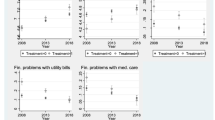Abstract
Static economic models based on complete demand systems are inadequate for estimating unconditional equivalence scales; in order to capture the effects of demographic changes on consumer behaviour, a life-cycle dynamic model is taken into account. In literature, studies have presented and evaluated longitudinal equivalence scales and intertemporal cost of children but these cannot be applied in practice when equivalence scales are utilised in poverty or income distribution analyses. This paper proposes intratemporal equivalent income scales, which are within period index numbers incorporating intertemporal consumer behaviour.
Similar content being viewed by others
References
Balli, F., Tiezzi, S.: Equivalence scales, the cost of children and household consumption patterns in Italy. Rev. Econ. Househ 8(4), 527–549 (2010)
Banks, J., Blundell, R., Lewbel, A.: Quadratic engel curves and consumer demand. Rev. Econ. Stat. 79, 527–539 (1997)
Banks, J., Blundell, R., Preston, I.: Life-cycle expenditure allocations and the consumption costs of children. Eur. Econ. Rev. 38, 1391–1410 (1994)
Barten, A.P.: Family composition, prices and expenditure patterns. In: Hart, P.E., Mills, P., Whitaker, J.K. (eds.) Econometric Analysis for National Economic Planning. Butterworths, London (1964)
Betti, G.: A nonparametric approach to equivalence scales. Stat. Trans. 7(1), 181–194 (1999a)
Betti G. (1999b), Quadratic Engel Curves and Household Equivalence Scales: the Case of Italy 1985–1994, Statistics Research Report LSERR50, London School of Economics
Betti, G., Lundgren, L.: The impact of remittances and equivalence scales on poverty in Tajikistan. Cent. Asian Surv. 31(4), 395–408 (2012)
Bierens, J.H., Pott-Buter, H.A.: Specification of household engel curves by nonparametric regression. Econ. Rev. 9, 123–184 (1990)
Bishop, J.A., Grodner, A., Liu, H., Ahamdanech-Zarco, I.: Subjective poverty equivalence scales for euro zone countries. J. Econ. Inequal. 12(2), 265–278 (2014)
Blundell, R., Lewbel, A.: The information content of equivalence scales. J. Econom. 50, 49–68 (1991)
Browning, M.J., Deaton, A.S., Irish, M.: A profitable approach to life-cycle labour supply. Econometrica 53, 503–543 (1985)
Charlier, E.: Equivalence scales in an intertemporal setting with an application to the former West Germany. Rev. Income Wealth 48, 99–126 (2002)
Cheli, B., Betti, G.: Fuzzy analysis of poverty dynamics on an Italian pseudo panel, 1985–1994. Metron 57(1–2), 83–104 (1999)
Deaton, A.: Panel data from time series of cross-sections. J. Econom. 30, 109–126 (1985)
Deaton, A.S., Muellbauer, J.: An almost ideal demand system. Am. Econ. Rev. 70, 312–326 (1980)
Dudek, H.: Do shares of food expenditure in the European Union converge? A country-level panel data analysis. Econ. Comput. Econ. Cybern. Stud. Res. 48(4), 245–260 (2014)
Fisher, F.M.: Household equivalence scales and interpersonal comparisons. Rev. Econ. Stud. 54, 519–524 (1987)
Gorman, W.: Tricks with utility functions. In: Artis, M.J., Nobay, A.R. (eds.) Essays in Economic Analysis: proceedings of the 1975 AUTE Conference, Sheffield. Cambridge University Press, Cambridge (1976)
Hagenaars, A.J.M., de Vos, K., Zaidi, M.A.: Poverty Statistics in the Late 1980s: research Based on Micro-Data. Official Publications of the European Communities, Luxembourg (1994)
Kapteyn, A., Van Praag, B.M.S.: A new approach to the construction of family equivalence scales. Eur. Econ. Rev. 7, 313–335 (1976)
Kot, S.: Inter-temporal equivalence scales based on stochastic indifference criterion: the case of Poland, paper presented to the IARIW 33rd General Conference, Rotterdam (2014)
Lewbel, A.: A unifying approach to incorporating demographic or other effects into demand analysis. Rev. Econ. Stud. 52, 1–18 (1985)
Majumder, A., Chakrabarty, M.: Estimating equivalence scales through engel curve analysis. In: Basu, B., Chakravarty, S.R., Chakrabarti, B.K., Gangopadhyay, K. (eds.) Econophysics and Economics of Games, Social Choices and Quantitative Techniques, pp. 241–251. Springer, New York (2010)
Moffit, R.: Identification and estimation of dynamic models with time series of repeated cross sections. J. Econom. 59, 99–123 (1993)
Muellbauer, J., Van de Ven, J.: Equivalence scales and taxation: a simulation analysis. In: Dagum, C., Ferrari, G. (eds.) Household Behaviour, Equivalence Scales, Welfare and Poverty, pp. 85–106. Springer, New York (2004)
Pashardes, P.: Contemporaneous and intertemporal child costs: equivalent expenditure versus equivalent income scales. J. Public Econ. 45, 191–213 (1991)
Pendakur, K.: Semiparametric estimation of lifetime equivalence scales. J. Appl. Econom. 20, 487–507 (2005)
Pollak, R.A., Wales, T.J.: Estimation of complete demand systems from household budget data: the linear and quadratic expenditure system. Am. Econ. Rev. 68, 348–359 (1978)
Pollak, R.A., Wales, T.J.: Welfare comparison and equivalence scales. Am. Econ. Rev. 69, 216–221 (1979)
Pollak, R.A., Wales, T.J.: Demographic variables in demand analysis. Econometrica 49, 1533–1551 (1981)
Ray, R.: Measuring the cost of children: an alternative approach. J. Public Econ. 22, 89–102 (1983)
Rojas, M.: Household equivalence scale. In: Michalos, A.C. (ed.) Encyclopedia of Quality of Life and Well-Being Research, pp. 2947–2950. Springer Netherlands, Dordrecht (2014)
Van Praag, B.M.S.: Individual Welfare Functions and Consumer Behaviour. North Holland, Amsterdam (1968)
Veerbek, M., Nijman, T.E.: Can cohort data be treated as genuine panel data? Empir. Econ. 17, 9–23 (1992)
Author information
Authors and Affiliations
Corresponding author
Rights and permissions
About this article
Cite this article
Betti, G. Quantifying the economic cost of children: a note on intertemporal equivalence scales. Qual Quant 51, 1197–1205 (2017). https://doi.org/10.1007/s11135-016-0325-2
Published:
Issue Date:
DOI: https://doi.org/10.1007/s11135-016-0325-2




